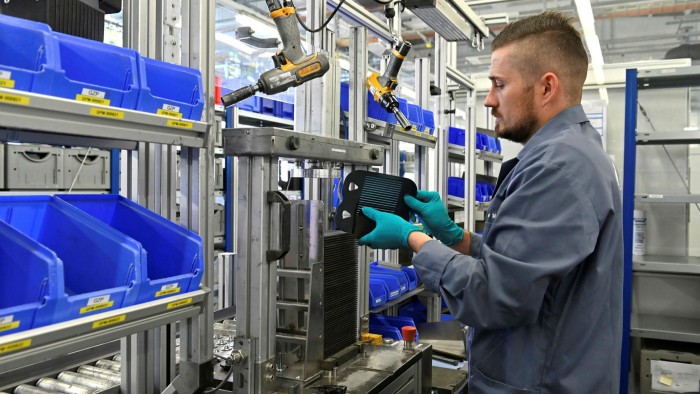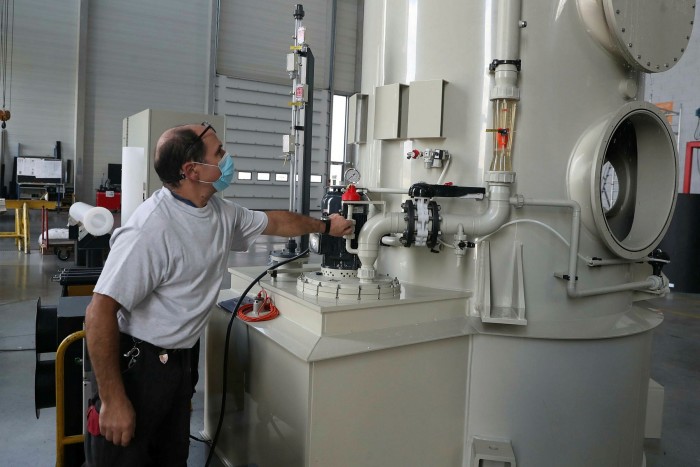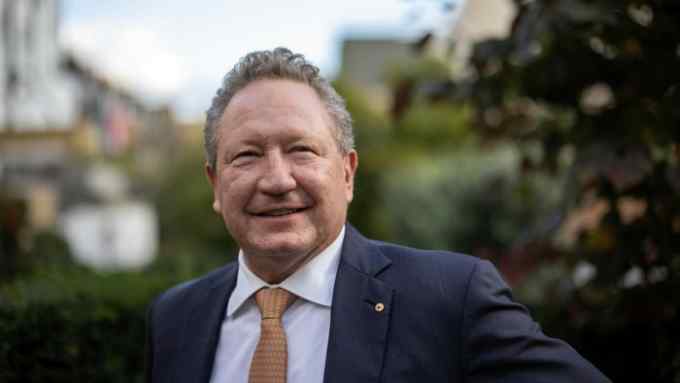EU clean energy targets risk being missed as rates rise

Roula Khalaf, Editor of the FT, selects her favourite stories in this weekly newsletter.
Green hydrogen is a key part of the European Commission’s strategy to cut its dependence on Russian fossil fuels and tackle the climate crisis — but economic conditions are putting projects, and targets, at risk.
From a standing start, Brussels plans to use 20mn tonnes of the clean burning fuel by 2030 under its new energy blueprint, dubbed RepowerEU, which also sets ambitious targets for renewable energy.
However, experts reckon the hydrogen target will be missed unless big projects are commissioned soon — something they say will be increasingly difficult against a backdrop of rising interest rates and possible power outages as Moscow turns the screw on gas supplies.
“The targets are very ambitious,” says Maximo Miccinilli, senior vice-president at FleishmanHillard, a public relations company. “Who is going to take the first risk and roll out a project when inflation and interest rates are going up?”
While there are many large hydrogen projects planned in Europe, final investment decisions have been taken on only a few. In part, that is a reflection of a need for greater clarity on regulation and subsidies, as well as a lack of committed customers.
This is sometimes referred to as the ‘chicken and egg’ problem. Developers are reluctant to start projects unless they have buyers, who in turn are reluctant to sign binding purchase agreements until ground has been broken.
That could change this summer if the commission announces that the Important Projects of Common European Interest (IPCEI) scheme is prepared to finance the hydrogen sector. However, with Germany planning to reopen mothballed coal plants, to avert an energy crunch this winter, Europe’s ambitions in hydrogen could be pushed down the political agenda until the crisis passes.
The commission sees green hydrogen — which is produced using water and renewable electricity, for use in place of natural gas, coal and oil — having a role in heavy industry and long-distance road transport.
Under its previous Fit for 55 climate package, the commission was targeting 5.6mn tonnes of hydrogen production by 2030. That target was raised in May to 20mn tonnes, split between 10mn tonnes of domestic production and 10mn tonnes of imports from countries with access to cheap renewable power.
In a staff working document, the commission said its “renewable hydrogen ambition” would cost in the range of €335bn to €471bn, with €200bn to €300bn needed for an additional 500 terawatt hours of renewable electricity production — equivalent to the annual consumption of France. This is seen as one of the key bottlenecks facing the industry.
The commission also said European electrolyser manufacturing capacity would need to be scaled-up “significantly” to meet the expected demand for renewable hydrogen production. Electrolysers are the machines that split water into its constituent molecules of hydrogen and oxygen.

Speaking at the FT Hydrogen Summit in London last month, Jon André Løkke, chief executive of Nel, a major manufacture of electrolysers, said the industry was ready to scale up, but only when “concrete” starts to be poured on big projects.
“Now, it is up to the EU and the downstream players, the users and producers of molecules, to start making investment decisions and building, and we will respond with the capacity,” he stated.
Those comments were echoed by Graham Cooley, chief executive of ITM Power, a rival electrolyser manufacturer. “We are ready to go, we just need the EC to put the incentives in place.”
More stories from this report
Other delegates at the summit said there was also a need for clear standards on what should be defined as green hydrogen before projects get financed.
Another issue confronting the industry arises from the so-called Delegated Acts, which that state that, by 2026, it will only be permissible to use electricity from newly constructed wind and solar plants to generate green hydrogen.
German utility company RWE has slammed these proposed rules, saying they will put the brakes on investment. Others say they offer the potential for common standards and a strong starting framework for the industry.
“All these things are very complex,” Julien Rolland, the of head of power and renewables at commodity trader Trafigura, told the FT conference. “What’s good is there is a lot effort, there’s a lot of intellect and there’s a lot of work at the EU level.”
Ultimately, Miccinilli says, the industry should not get too obsessed by the European targets for green hydrogen, given the energy crisis facing the continent. Instead, it should focus on the policy enablers and new frameworks needed to build a market. “It is all about execution,” he says.

Comments